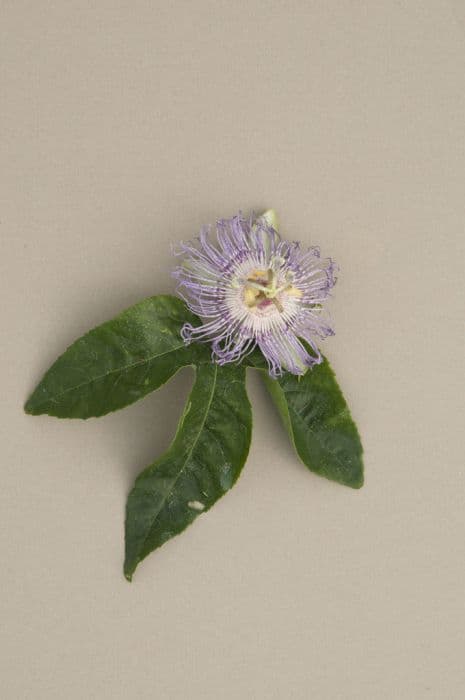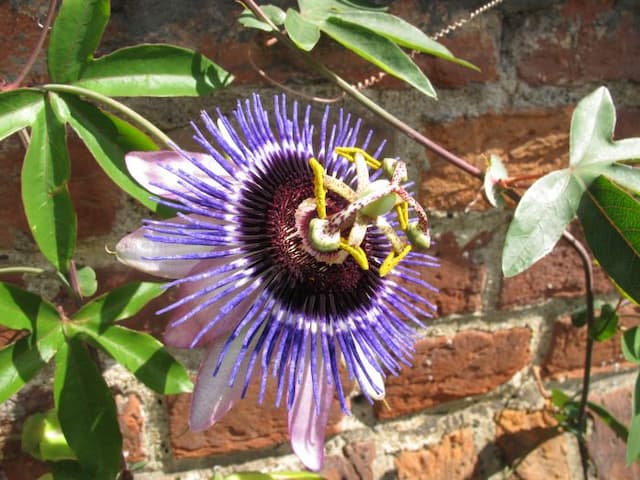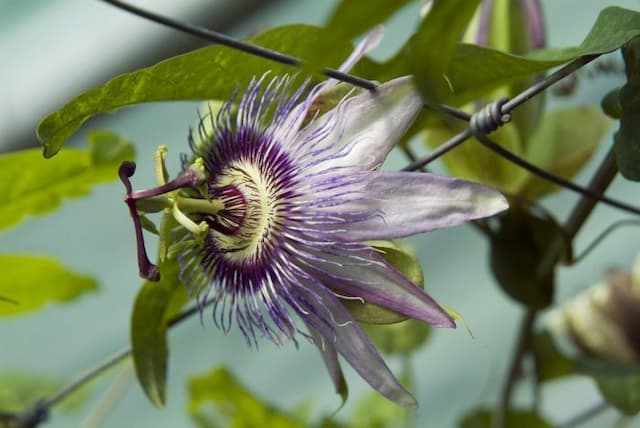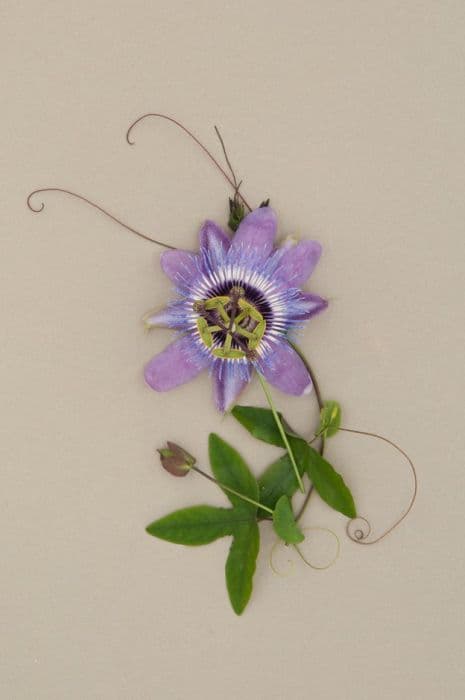Blue Passionflower Passiflora caerulea

ABOUT
Passiflora caerulea, commonly known as blue passionflower, boasts a striking appearance with its complex and exotic-looking flowers. The flowers are renowned for their intricate structure and vibrant color palette, usually featuring a base color of white with hints of blue or lavender. The most eye-catching parts of the flower are the filaments which come in different shades of purples and blues, creating a striking contrast against the creamy white petals and sepals. In the center, the blue passionflower has a ring of filaments that are known as the corona, which is often banded with various shades of blue and white. These filaments surround a central column composed of the stamens and pistils, which protrude outward, adding to its dimensional allure. The flowers typically measure a few inches across, making them a prominent and showy feature of the vine. The foliage of the blue passionflower consists of large, glossy green leaves that are deeply lobed, usually with five points, and sometimes more, giving them a palmate appearance. The leaves provide a lush backdrop for the striking flowers and also feature coiling tendrils that the vine uses to clasp onto supporting structures and other plants as it climbs. Additionally, the blue passionflower can produce egg-shaped orange berries called maypops. These fruits add an additional point of interest to the plant, transitioning from green as they begin to form, to bright orange when ripe. The contrast between the fruit and the rich green foliage can be quite decorative. Together, the striking flowers, lush foliage, and climbing habit of the blue passionflower make it a favorite among gardeners looking for a plant with a tropical flair and distinctive blooms.
About this plant
 Names
NamesFamily
Passifloraceae.
Synonyms
Blue Passionflower, Bluecrown Passionflower, Common Passion Flower, Flower Of Five Wounds, Southern Beauty, Wild Apricot, Jesus Flower, Passion Vine, Blue Passion Vine.
Common names
Passiflora caerulea L.
 Toxicity
ToxicityTo humans
The common name of Passiflora caerulea is blue passionflower. Blue passionflower is not considered highly toxic to humans, but some parts of the plant may contain cyanogenic glycosides, which can release cyanide in the body if ingested in large quantities. Symptoms of cyanide poisoning can include headache, nausea, vomiting, abdominal pain, dizziness, and in severe cases, respiratory failure and death. However, poisoning from passiflora species is rare, and the fruit of blue passionflower is edible when ripe.
To pets
The common name of Passiflora caerulea is blue passionflower. Blue passionflower is generally considered to have a low level of toxicity for pets, such as dogs and cats. However, the ingestion of significant amounts of the plant, specifically the leaves or unripe fruit, may lead to mild gastrointestinal upset, including symptoms such as vomiting or diarrhea. Severe poisoning is uncommon, but it is always advisable to keep an eye on pets after ingestion of any plant material and consult a veterinarian if any worrying signs are observed.
 Characteristics
CharacteristicsLife cycle
Perennials
Foliage type
Semi-deciduous
Color of leaves
Green
Flower color
Mixed
Height
10-15 feet (3-4.5 meters)
Spread
6-8 feet (1.8-2.4 meters)
Plant type
Climber
Hardiness zones
7
Native area
South America
Benefits
 General Benefits
General Benefits- Ornamental value: Passiflora caerulea, commonly known as blue passionflower, adds aesthetic appeal to gardens with its striking flowers and unique structure.
- Pollinator attraction: The plant's vibrant flowers attract pollinators such as bees, butterflies, and hummingbirds, supporting local ecosystems.
- Food source for fauna: Its fruits serve as a food source for various wildlife species, including birds.
- Cultural significance: In some traditions, the flower is used symbolically in religious and cultural ceremonies.
- Shade provision: With its vigorous growth, the blue passionflower can cover pergolas and trellises, providing natural shade in garden spaces.
- Privacy screen: When grown on fences or walls, it can act as a living screen, offering privacy and reducing noise from outside sources.
- Soil stabilization: The extensive root system helps to prevent soil erosion in the garden or landscape where it is planted.
 Medical Properties
Medical Properties- Anxiolytic effects: Passiflora caerulea has been traditionally used to help reduce anxiety.
- Sedative properties: It may promote relaxation and improve sleep quality.
- Antispasmodic effects: May help in relieving muscle spasms or cramps.
- Analgesic potential: Sometimes used to alleviate mild pains and aches.
 Air-purifying Qualities
Air-purifying QualitiesThis plant is not specifically known for air purifying qualities.
 Other Uses
Other Uses- As a natural food dye: The petals of Passiflora caerulea can be used to extract a natural blue dye for use in foods and textiles.
- As a teaching tool in religion: The Blue Passion Flower is sometimes used as a visual aid to explain the Passion of Christ, with its components symbolizing the crucifixion, including the crown of thorns.
- In landscape gardening: Due to its climbing nature, Passiflora caerulea is used to cover trellises, fences, and walls to create visually pleasing green spaces.
- As an educational specimen: In botany classes, the complex structure of the flower is used to teach about plant anatomy and pollination mechanisms.
- For fragrance in potpourris: The flowers and sometimes the leaves are added to potpourri mixes for their light, pleasing scent.
- In crafting and floristry: The unique flowers are used in the creation of floral arrangements and botanical arts for their intricate and exotic appearance.
- For butterfly gardening: The plant is grown to attract and feed butterflies, particularly in gardens designed to support these pollinators.
- As a component in perfumery: The fragrance of the flowers can be used in perfumery, although it's less common than other aromatic plants.
- In companion planting: The Blue Passion Flower can be planted alongside vegetables as it attracts beneficial insects that help in pollination or pest control.
- In cultural ceremonies: In some cultures, Passiflora caerulea symbolizes peace and friendship and is used in ceremonies to convey these meanings.
Interesting Facts
 Feng Shui
Feng ShuiThe Blue Passion Flower is not used in Feng Shui practice.
 Zodiac Sign Compitability
Zodiac Sign CompitabilityThe Blue Passion Flower is not used in astrology practice.
 Plant Symbolism
Plant Symbolism- Passion and Suffering: Passiflora caerulea, commonly known as Blue Passion Flower, has a detailed structure that Christian missionaries used as a symbol to describe the Passion of Christ, with its tendrils representing the whips used in the flagellation, the ten petals and sepals representing the ten faithful apostles, and the radial filaments symbolizing the crown of thorns.
- Spiritual Enlightenment: Due to its unique and intricate floral parts, the Blue Passion Flower is also seen as an emblem of spiritual enlightenment and a divine sign of beauty and complexity in the world.
- Peace and Serenity: With its calming blue color and soothing scent, the Blue Passion Flower is often associated with peace and serenity, making it a symbol for quietude and meditation.
- Exotic Mystery: Its striking appearance gives it an air of mystery, often representing the allure and enigma of far-off, exotic places.
- Martyrdom: In religious context, Blue Passion Flower represents faith and martyrdom, embodying the idea of suffering and devotion for a cause or belief.
 Water
WaterThe Blue Passion Flower requires regular watering but does not do well with over-saturation or prolonged dryness. During the growing season, typically from spring to fall, water thoroughly, ensuring moisture penetration to about 6 inches deep, whenever the top inch of the soil feels dry. This might equate to watering with approximately 1 gallon of water per week depending on climate and weather conditions. In the winter months, reduce watering but do not allow the soil to completely dry out; providing about half a gallon every two weeks should be sufficient. Monitor the plant and soil moisture to adjust watering as needed since environmental factors can vary greatly.
 Light
LightBlue Passion Flowers thrive best in full sun to partial shade. The perfect spot for a Blue Passion Flower is a location where it can receive at least four to six hours of direct sunlight daily. If indoor placement is necessary, a bright south or west-facing window where the sunlight is most intense will be beneficial for its growth.
 Temperature
TemperatureThe Blue Passion Flower prefers a temperature range between 50°F and 90°F. It can survive minimum temperatures down to about 20°F but should be protected from frost to prevent damage; mulching can help insulate the roots. The ideal condition for this vine is a warm, temperate climate where frosts are minimal, ensuring vibrant growth and flowering.
 Pruning
PruningPruning the Blue Passion Flower helps maintain its shape, encourage more robust growth, and prevent overgrowth. The best time to prune is in early spring, before new growth begins. Cut back dead or overgrown branches to stimulate flowering. Prune lightly throughout the year to keep the vine manageable and to promote a tidy appearance. Major pruning should be limited to once a year unless the plant becomes unruly.
 Cleaning
CleaningAs needed
 Soil
SoilBlue Passionflower thrives in well-draining soil with a pH of 6.1 to 7.5. A mix of peat, loam, and sand or perlite is ideal to ensure proper drainage and aeration. Regularly enrich the soil with compost or a balanced fertilizer to support its vigorous growth.
 Repotting
RepottingBlue Passionflower should be repotted every 2 to 3 years to refresh the soil and accommodate its fast-growing roots. Larger pots will support more substantial growth, but ensure they provide ample drainage.
 Humidity & Misting
Humidity & MistingBlue Passionflower prefers moderate to high humidity levels. Aim for a humidity level of around 40-50% for optimal growth, avoiding environments that are too dry to keep the plant healthy.
 Suitable locations
Suitable locationsIndoor
Place Blue Passionflower in a bright spot and provide a trellis for support.
Outdoor
Plant in full sun to partial shade and provide structure for climbing.
Hardiness zone
6-10 USDA
 Life cycle
Life cyclePassiflora caerulea, commonly known as blue passionflower, begins its life cycle when seeds are dispersed by animals or gravity near the mother plant and germinate in moist, well-drained soil. After germination, seedlings emerge and grow rapidly, developing a root system and climbing stems with the help of tendrils. Vegetative growth continues with the formation of characteristic lobed leaves, and once mature, the plant produces intricate blue and white flowers, which are typically self-pollinated or cross-pollinated by insects. Following successful pollination, the flowers develop into oval or round fruits containing numerous seeds, ready to be dispersed. The blue passionflower is a perennial plant, meaning it will enter a dormancy period in colder climates and regrow from the same root system the following spring. Over time, the plant may spread and form extensive coverage, often requiring pruning to manage its growth.
 Propogation
PropogationPropogation time
Spring to early summer
The Blue Passionflower, Passiflora caerulea, is most commonly propagated through seed sowing. The best time for this is in late winter to early spring. To propagate by seed, one should first soak the seeds in warm water for 24 to 48 hours to soften the seed coat, which will improve germination rates. Sow the seeds in a well-draining seed mix, lightly covering them with soil. Place the container in a warm area with temperatures around 68 to 75 degrees Fahrenheit (20 to 24 degrees Celsius) and keep the soil consistently moist. Germination can take several weeks, and once seedlings have grown strong enough, they can be transplanted into individual pots and gradually acclimatized to outdoor conditions before planting them in their final location.









